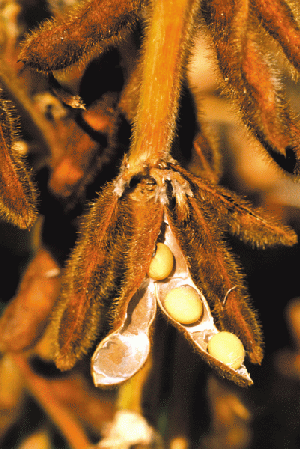
“Thanks to some scattered showers over the past couple of months, we have potential for a good crop over much of the area, with soybean prices over $16, and at one time over $17 cash price for new crop beans,” says David Glidewell, Mid-South regional manager for ADM at Memphis. “But, drive 80 to 100 miles north of Memphis, where the drought has been ongoing, and the difference is stark," he said at the Mississippi Farm Bureau Federation and Mississippi Soybean Association joint soybean advisory committee meeting at Grenada, Miss.

“It’s a very exciting time to be a Mid-South soybean producer,” says David Glidewell, Mid-South regional manager for ADM at Memphis.
“Thanks to some scattered showers over the past couple of months, we have potential for a good crop over much of the area, with soybean prices over $16, and at one time over $17 cash price for new crop beans,” he said at the Mississippi Farm Bureau Federation and Mississippi Soybean Association joint soybean advisory committee meeting at Grenada, Miss. “But, drive 80 to 100 miles north of Memphis, where the drought has been ongoing, and the difference is stark.
“It’s no big secret it’s very dry in central Illinois, central Indiana, and other areas, with some pretty dire situations. Southern Indiana, southern Illinois, western Kentucky, are among the toughest areas. North of there, in Minnesota, Nebraska, Wisconsin, Iowa, and South Dakota, where they’ve had more rain, yield potential for corn and soybeans is better, although it has started to get dry in those areas, too.”
The severe drought, Glidewell says, “is being compared to droughts of 1988 and 1980, and some say it could be similar to 1952, when there was the drought of all droughts.
Report: Mississippi soybeans need moisture to finish strong
“We still have time to make a good crop — but if we get to Aug. 1 or Aug. 10 and the Midwest hasn’t had some rain to keep their crop meeting its potential, I think we’ll see higher futures prices.”
Several factors have played a role in bringing the market to its current lofty level, Glidewell says.
“There’s the ever-increasing appetite for soybeans around the world, most notably in China. Then last year South America had a 20 million metric ton shortfall versus what had been anticipated for their crop, and that started soybean prices rallying.
“The market was expecting the U.S. to pick up that shortfall with this year’s crop. But then it looked as if we were going to reduce soybean acres in favor of corn, and very quickly we were able to trade $12 to $13 soybeans for fall delivery. After that came the weather concerns in the Midwest, and prices rallied sharply.
“Some analysts will say the soybean market has not yet done the job of rationing — we’re getting close, but we’re not there.”
Read: ADM manager says 'make the market make you sell soybeans'
This year’s world soybean forecast is for 236 million metric tons, Glidewell notes, and the 2012/13 forecast is for just over 267 million tons.
“That’s assuming South America will recover to a normal yield and will increase acreage to the maximum they practically can — most analysts would say a 5 percent acreage increase is about all they can manage.
“If this occurs, we could expect to see world soybean production up sharply, although in July the expected increase was reduced by about 1.5 percent, mostly due to worsening June-July conditions in the U.S.”
In the 2012/13 forecast for U.S. soybeans, he says, the projected yield in the last Supply and Demand report was 40.5 bushels per acre, which would result in 130 million bushels of ending stocks, for a very tight 4.2 stocks-to-use ratio.
“Many analysts are saying when we set the highs last week, $16.91 ½ for Nov. 2012 soybeans, most of the trade was trading based on what they thought was a 38-bushel national average. Soybeans were down 64 cents today (July 23), because the market’s perception of yield had changed based on a more favorable weather forecast in the Midwest, and it illustrates how sensitive the market is to weather forecasts.
“But, if take that 130 million bushel carryover and reduce the national yield to 38 bushels per acre, you end up with a negative 74 million bushel carryover. If you drop the national average to 36 bushels per acre, you would have a negative carryover of 224 million bushels. We all know it’s impossible to have a negative carryover.”
Near pipeline levels
If the U.S. average soybean yield comes in 38 bushels per acre as projected, Glidewell says, “Then, what has to happen is that we have to ration demand out of the market. We’ve got to take total use down to a number that will leave us with a carryover. Some say we need at least 100 million bushels for pipeline stocks in the U.S.
“Most likely today, the market perceives that the U.S. still has a very good chance to make a 40 bushel national average — if sufficient rains come to the Midwest in the next week or two. But the farther we go without that rain, the more critical the situation becomes, and the much higher the likelihood becomes there will be irreparable damage to soybean yield potential across the country. And also, the less likely we’ll approach the 40.4 bushel yield we currently have on our balance sheet.”
If the rains don’t come, Glidewell says, “Then soybeans will have to rally to force demand out of the market — get the price high enough that certain segments of the market will reduce the pace at which they buy soybeans.
“If the market starts to really believe we’ll have a 38-bushel soybean crop in this country, I think we could very easily see demand rationed out to the point of 200 to 300 million bushels, maybe more.
Report: Drought could lead to crop delivery problems
“How you do that? One way, you reduce crush by making the soybean meal price so high that it’s not profitable for producers, such as the poultry industry, to use it. Or maybe a Chinese customer will draw down reserves at a faster pace than they would normally in an effort to get into the new South American marketing year, when they’d expect to have a fresh supply of new beans, hopefully at much cheaper prices. Today, the market for November soybeans is much higher than for April/May.
“We’re on a market seesaw, and weather forecasts are still a very important influence on the soybean pricing structure right now. Some would say the demand figure is higher than estimated and that we’re already down to less than pipeline stocks, in which case a reduction in projected U.S. yield could mean some new historical price highs.”
Glidewell said he asked analysts for yield/price equivalents based on various national yield averages, and what each scenario would require to ration demand.
“For a national average between 36 and 38 bushels, the responses I got ranged from $18 to $19 November futures; for 35 bushels or below, they said we’d be trading beans with a 20 in front of the price. Soybeans, unlike corn, can do more with a half-inch rain — they’re a much more efficient user of water and can preserve yield a lot longer.”
In most years, when demand is rationed, he says, “The first cutback is in exports, because normally the export market is a means to get rid of our surplus. But the Chinese demand is a such a huge part of our demand base right now that it’s pretty much built in. The world has nowhere else to turn for soybeans until next February or March, when we start seeing how things look with the South American crop.
“This means that the rationing process — if we get into a situation where people feel that U.S. crop yields are really threatened and we’re headed to a reduced mid-30s national yield average —could get very, very violent.”
The U.S. has currently has open sales of 535 million bushels of soybeans, Glidewell says, all in the 2012/13 marketing year, not quite half of projected exports. “So, there’s still time to ration some exports out of the market if we have to.”
The Chinese began buying current year U.S. soybeans last fall, he says, when it became obvious the South American crop wasn’t going to be up to expectations, and they have continued to buy.
In addition to strong soybean prices, Glidewell says, basis levels have been “very, very strong historically for the fall delivery period. We’ve seen not only all-time strong soybean prices, but we’ve also seen some historically strong basis levels, delivered.”
In the soybeam meal market, he says, crushers have seen “a little improvement” in their margins in the last 30 days. “The industry has struggled over the past two years with just brief periods of profitable margins, and periods of break-even to barely below break-even. That’s because there was too much soybean crushing capacity in the U.S. But, the shortfall in the South American crop has brought the world buyer back to the U.S. for meal at a time when they normally wouldn’t be buying. This has helped support soybean prices, and soybean meal demand has been better than we’d expect it to be in the summertime.”
Improvement in soybean varieties and better farming techniques have allowed growers to achieve significant increases in soybean yield potential, Glidewell says.
“If we compared the potential of Mid-South soybean varieties today to those in 1985, when we were pretty pleased with 30 bushel yields year-in, year-out, we’ve come a long way to now having varieties with yield potential of 80 bushels or better.
“Mid-4 maturity beans have done a lot to accelerate yield potential in the Delta, as long as water isn’t a limiting factor. On a year-in year-out basis, Mid-South growers can produce soybean yields just as good as Midwest growers. Heat still is a limiting factor with our corn yield potential, but with soybeans, we now have excellent yield potential.”
About the Author(s)
You May Also Like



